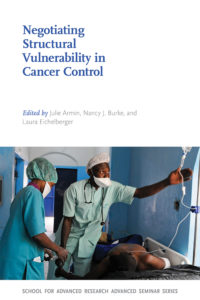Reviewed Book
Negotiating Structural Vulnerability in Cancer Control. Julie Armin, Nancy J. Burke and Laura Eichelberger, editors, Albuquerque: University of New Mexico Press, 2019, 320 pp.

Negotiating Structural Vulnerability in Cancer Control highlights the continuing lack of equity in cancer care. At the heart of the essays assembled in this volume are two questions: “What can case studies about the lived experiences of and discourses related to cancer contribute to the burgeoning interest in the concept of structural vulnerability? And can a consideration of structural vulnerability enhance applied anthropological work in cancer prevention and control?” (p. 2). The contributors address these questions on the basis of ethnographic research conducted in a number of locations, most of them in the United States.
The concept of structural vulnerability is a modification of Galtung’s structural violence. While the latter placed emphasis on the violence, the former focuses on the positionality of people who find themselves exposed to such violence. According to the editors, structural vulnerability is a “positionality that imposes physical-emotional suffering on specific population groups” (p. 2). Vulnerability, in this view, is produced by a person’s place in a broader social, cultural, political and economic order. In his Afterword, James Quesada puts it succinctly: “The concept of structural vulnerability builds upon social suffering and structural violence by recognizing how individuals and communities are susceptible to the forces of violence and needless suffering by virtue of their social position in society” (p. 226). In this phrasing, violence appears as a “force” to which people are “susceptible.”
Among the most compelling contributions to this volume is Simon Craddock Lee’s essay on lung cancer patients in Dallas, Texas. Lee suggests that the emphasis on structural vulnerability “risks a sense of inevitability of vulnerability that could obscure the myriad ways that people respond and resist their positionality” (p. 93). This observation is important because it refuses both vulnerability and violence as inevitable. The task, accordingly, is not only to describe and document structural vulnerability but to trouble it.
Equally interesting in terms of troubling structural vulnerability is Maria Stalford’s essay on the migration of rural patients to urban hospitals in Vietnam. It is one of the few contributions to this volume that expands our understanding of cancer care beyond the global North. As Salford shows, patients in Vietnam often travel long distances to access cancer care in tertiary hospitals, which are almost exclusively located in urban centers. Such domestic travel can extend over weeks, months, and sometimes even years. In Vietnam, “patients have shown a willingness to bypass more proximate facilities in favor of those where they anticipate receiving higher quality or more reliable care” (p. 134). Here, it would have been fascinating to explore in more detail what “higher quality” actually means for these patients—what exactly is driving people to the big hospitals in the big cities, in Vietnam and elsewhere? What imaginations of cancer, care, and cure are at work here? Distance, as a “barrier to health care” and a “source of structural vulnerability,” operates dialectically; it is both an obstacle and a mobilizing force. It constitutive of the desperate hope that often drives people out of the local into an unknown world.
One might wish the editors had taken a bolder analytical approach to the foundational concept of structural vulnerability. The volume’s title—Negotiating Structural Vulnerability—suggests optimistic pragmatism. However, as many scholars have pointed out, the idea of vulnerability is not innocent. It can be mobilized in all kinds of projects and for all kinds of politics. That some people are more likely to experience forms of violence is undeniable and has been shown in multiple studies. What it means and how we should respond to it is less clear. Is “negotiation” ambitious enough? The metaphor has advantages for empirical research projects, but it has ethical and political limits for the ways in which we might want to imagine our lives today.
Alongside the classic books by Lochlann Jain (Malignant, 2013) and Julie Livingston (Improvising Medicine, 2012), Negotiating Structural Vulnerability is relevant for scholars working on cancer and can be assigned in undergraduate and graduate medical anthropology and medical sociology as well as public health, medical, and nursing program courses on the politics of medicine.
References Cited
Jain, L. 2013. Malignant. How Cancer Becomes Us. Berkeley: University of California Press.
Livingston, J. 2012. Improvising Medicine. An African Oncology Ward in an Emerging Cancer Epidemic. Durham: Duke University Press.